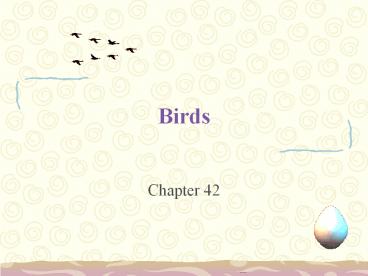Birds - PowerPoint PPT Presentation
1 / 36
Title:
Birds
Description:
Birds Chapter 42 – PowerPoint PPT presentation
Number of Views:214
Avg rating:3.0/5.0
Title: Birds
1
Birds
- Chapter 42
2
Origin and Evolution of Birds
- Section 42.1
3
Important characteristics
- Feathers only birds have them!
- Wings modified forelimbs
- Lightweight, rigid skeleton hollow bones
- Endothermic metabolism 104-106o F
- Unique respiratory system most efficient
- Beak no teeth
- Oviparity eggs incubated by parents
4
Evolution
- Similarities to dinosaurs
- Flexible, S-shaped neck
- Unique ankle joint
- Hollow bones
- Birds evolved from small, fast-running
carnivorous dinosaurs - Oldest bird fossil - Archaeopteryx
5
Archaeopteryx
- Jurassic period 150 million years ago
- Similar to modern birds because
- Hollow bones
- Furcula fused collarbone (aka wishbone)
- Feathers
- Similar to dinosaurs because
- Teeth
- Claws on forelimb
- Long, boney tail
6
Origin of flight
Video
- Two major hypotheses
- Ancestors were tree dwellers that ran along
branches and jumped from tree to tree, gliding
wings first evolved then the ability to flap came
later. - Ancestors were land dwellers that leapt after
their prey, wings served to trap or knock down
prey and over time became large enough to fly.
7
Feathers
- Modified scales
- Two main functions
- Provide lift for flight
- Conserve body heat
- Types of feathers
- Down feathers insulation
- Contour feathers streamline shape, coloration,
insulation - Flight feathers on wings and tail for flight
8
Parts of a feather
9
Structure of the feather
- Follicles tiny pits that feather develops from
- Rachis (Shaft) emerges from the follicle
- Vanes 2 vanes on opposite side of shaft
- Barbs branches of the vane
- Barbules projections on the barbs with
microscopic hooks - Keratin protein that makes up the feather
10
Care of feathers
- Preening use beak to rub feathers with oil
secreted by the preen gland at the base of the
tail. - Molting or shedding of feathers periodically
11
Characteristics of Birds
- Section 42.2
12
Skeleton Muscles
- Thin, hollow bones fused together
- Sternum breastbone is attachment point for
flight muscles - Pygostyle last fused vertebrae that supports the
tail feathers - Flight muscles account for 50 of birds weight
13
(No Transcript)
14
Metabolism
- Endothermic therefore require large quantities of
food to generate heat - Aquatic birds have a layer of fat to insulate
- Cannot go through long periods of time without
food
15
Digestive Excretory Systems
- Path of food mouth ? esophagus ? crop ? 2-part
stomach (proventriculus gizzard) ? small
intenstine with bile from liver ? large intestine
? cloaca ? vent - Path of wastes blood ? kidneys ? ureters ?
cloaca (mixes with feces) ? vent
16
Digestive System
17
Respiratory System
- Highly efficient
- Path of air nostrils ? trachea ? branched
bronchi ? lungs (25) or air sacs (75) - Air sacs
- 9 total
- Stores excess air
- Allows for oxygenated air in lungs during exhale
and inhale
18
Respiratory System
19
Circulatory System
- Rapid heartbeat
- Up to 1000 beats per minute!
- 4 chambered heart
- Like mammals
20
Nervous System Sense Organs
- Large brains (relative to body size)
- Some birds have color vision and/or binocular
vision - Some birds have a developed sense of smell
- Sense of hearing also important
21
Reproduction
- Sperm movement testies ? vasa deferentia ?
cloaca ? females cloaca - Egg movement ovary ? oviduct ? fertilized by
sperm ? addition of shell ? cloaca ? vent
22
Nest Building Parental Care
- Lay eggs in nest
- Methods of rearing young
- Precocial active as soon as hatch
- Atricial helpless when born
- One or both parents incubate eggs by sitting on
them and covering them with their brood patch - Thickened, featherless patch of skin on abdomen
23
What type is this?
Video
24
Migration
Video
- Seasonal movement of birds from one habitat to
another - Cues to help navigate
- Position of sun and stars
- Topographical landmarks
- Magnetic field
- Air pressure
- Ornithologist biologist that study birds
25
Classification of Birds
- Section 42.3
26
Diversity
- Beak and claws infer diet and habitat
- Most widespread terrestrial animal on planet
- 23 orders of birds
27
Order Anseriformes
- Examples swans, geese, and ducks
- Aquatic
- Webbed feet
- Flattened bill
- Precocial young, care by female
28
Order Strigiformes
- Examples owls nocturnal raptors
- Sharp, curved beak
- Sharp talons
- Keen sense of hearing to detect prey
29
Order Apodiformes
- Examples hummingbirds swifts
- Small, fast-flying
- Tiny feet
- Long, narrow beak
30
Order Psittaciformes
- Examples parrots, parakeets, macaws, cockatoos,
cockatiels - Live in the tropics
- Strong, hooked beak for opening seeds
- Two toes forward, two toes backward for climbing
perching - Highly vocal
31
Order Picformes
- Examples woodpeckers toucans
- Nest in tree cavities
- Diversity of bills based upon diet
- Same feet as parrots
32
Order Passeriformes
- Examples familiar birds (robins, blue jays,
cardinals, etc) - perching birds 3 toes forward, 1 toe backward
- songbirds males produce songs to attract mate
and warn away other males - Syrinx produces sound at base of trachea
33
Order Columbiformes
- Examples pigeons doves
- Plump-breasted, small heads
- Short neck, legs, and beak
- Crop secretes nutritious milk-like fluid to feed
young - Crop milk
34
Order Ciconiiformes
- Examples herons, storks, raptors, penguins
- World-wide distribution
- Habitat determines adaptations
- Many are wading birds
35
Order Galliformes
- Examples turkeys, pheasants, chickens, grouse,
quail - Fowl
- Terrestrial birds
- Plump-bodies with limited flying ability
36
Order Struthioniformes
- Examples ostriches emus
- Worlds largest birds
- Reduction in toe number to allow for fast running































